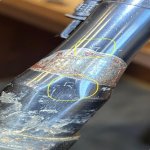- Location
- Nova Scotia
You ask the guy who you bought it from?
If it was rechambered markings be on the barrel.
If it was rechambered markings be on the barrel.
When you cast or "slug" the bore - if it is a 308 Win, should be .300" from top of one rifling to top of opposite rifling - very hard to get accurate measurement if it is a British "odd" numbered groove, like 3 or 5. The groove diameter should be .308" - that is the spec - actual production might have varied from that. For 303 British, should have been 0.303" from top of rifling to top of rifling, and in theory should be 0.311" groove to groove, although I have read of some groove sizing as much as 0.317" - war time standards back then were not like modern CNC standards.
Be aware that over the years, was VERY possible that an entirely different than original barrel was made and fitted to that receiver - it might "look" old, but might have been done 50 years after the rifle was made. To convert to 308 Win, (invented circa 1950's) probably requires a new barrel, a 303 British barrel probably too large chamber, too large bore. Was a thing at one time to make a "hybrid" - so a 308 Win chamber, but using 303 British bullets - so you could "set back" an original barrel - re-do the chamber, and continue to use that original sized bore - was often referred to as 30-303 or 308-303 or similar. I think the extractor in the bolt head might have had to be replaced to be able to grab the 308 Win rim - but maybe military 303 extractor worked for that?
Looking at your pictures - I do not think that barrel has a "knox form" - a flat area on top of the chamber area of the barrel - I am not sure that any SMLE barrels were done like that - goes to someone's work - NOT a military replacement or an "original" barrel.

It's a 5 groove bore.
.307 win is a good thought, I have a friend who says he may have ammo I can try to see if it would feed out of this mag. That's what doesn't make sense to me, if someone went to the trouble of rechambering it to .308 Win why wouldn't it have a mag that was made or modified for that round? Unless it's an unfinished project.
If it WAS .308 Win, does anyone know if an Ishapore 2A 7.62 magazine would work in this rifle's magazine well?
If you want to quickly find out whether the bore is .308 or .303, just stick a .308 cartridge, bullet first, into the muzzle. If it goes all the way in to the case neck, it's probably a .303. If if only goes in partially, it's a porbably a .308 bore. My money is also on a .307 WIN though.
Yeah tried that with a .308 bullet, it etches into the rifling on the ogive. Also made a cast of the bore but as was mentioned with a 5-groove bore you can't measure straight across groove to groove.
Could you drill a 19/64 hole in thin metal and ream it out to .308 and try it over the bore cast ? or a 5/16 (.312) drilled hole and see if it is a bit of a loose fit over the bore cast?(have read that a drilled hole may not be perfectly circular though, whereas a carefully reamed hole should be ) . Rick
So here's the other question that's come up in my online reading - many say it's unsafe to fire .308 out of an SMLE action because they can't handle the higher pressure (about 10k psi more than a .303 Brit) so even if I sort everything else out what are my options if that's the case? Light loads, Trail Boss only?
307 and 308 Winchester are excellent cast bullet cartridges. I have been trying a few different loads in each but haven’t decided what loads are best. Once the weather warms up I’ll probably start shooting them more. Using 2400 and 170 or 180 cast.So here's the other question that's come up in my online reading - many say it's unsafe to fire .308 out of an SMLE action because they can't handle the higher pressure (about 10k psi more than a .303 Brit) so even if I sort everything else out what are my options if that's the case? Light loads, Trail Boss only?
This was my thinking, front of a case head separation stuck in chamber.Broken neck of a previous fired round stuck in chamber maybe?
This is probably easy.
You got your sample. Looks v good.
Take your measurements and confirm the book "Cartridges Of The World" over 1500 cartridges all with a pic and at back of book every one has measurements for Nec dia, Shoulder dia, Base dia, Rim dia, Rim thickness, Case length + a few others too.
There is your awnser.
Had a bag once over 200 unmarked cartridges IDed most. Even wildcats and I am an Obsolete Calibre Man.








































